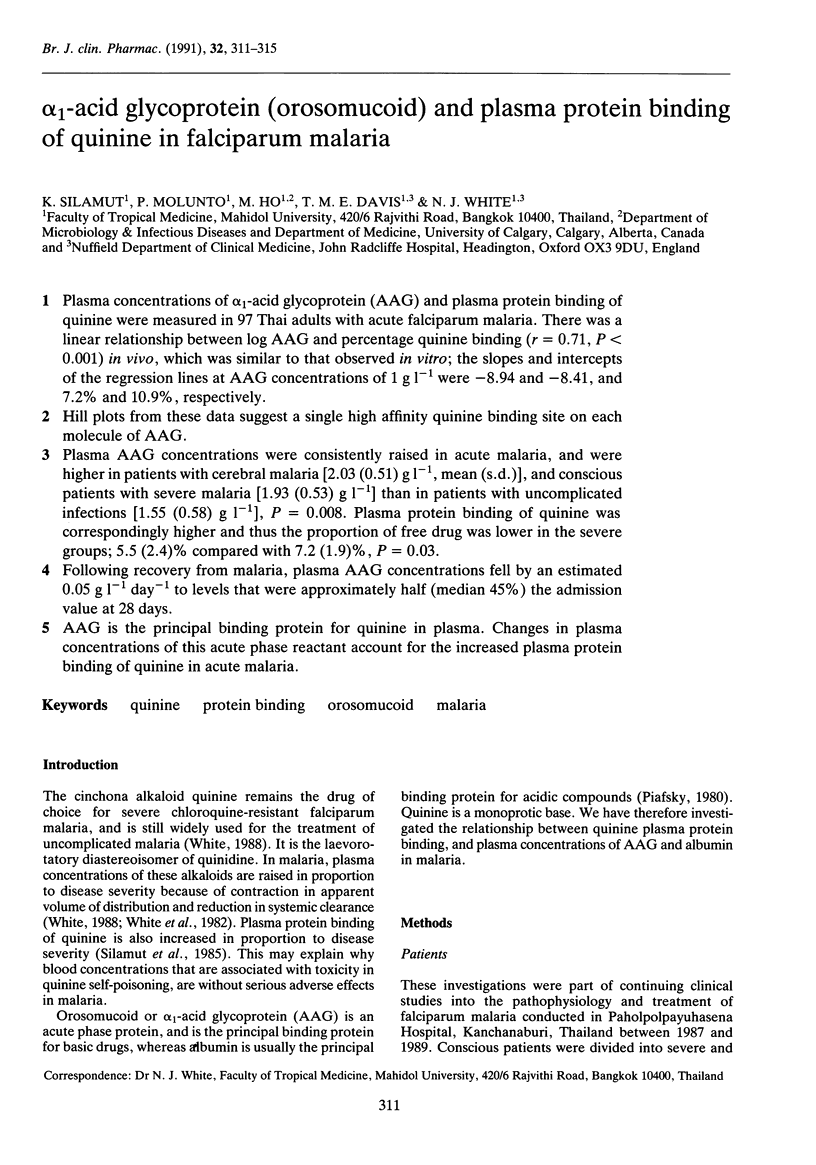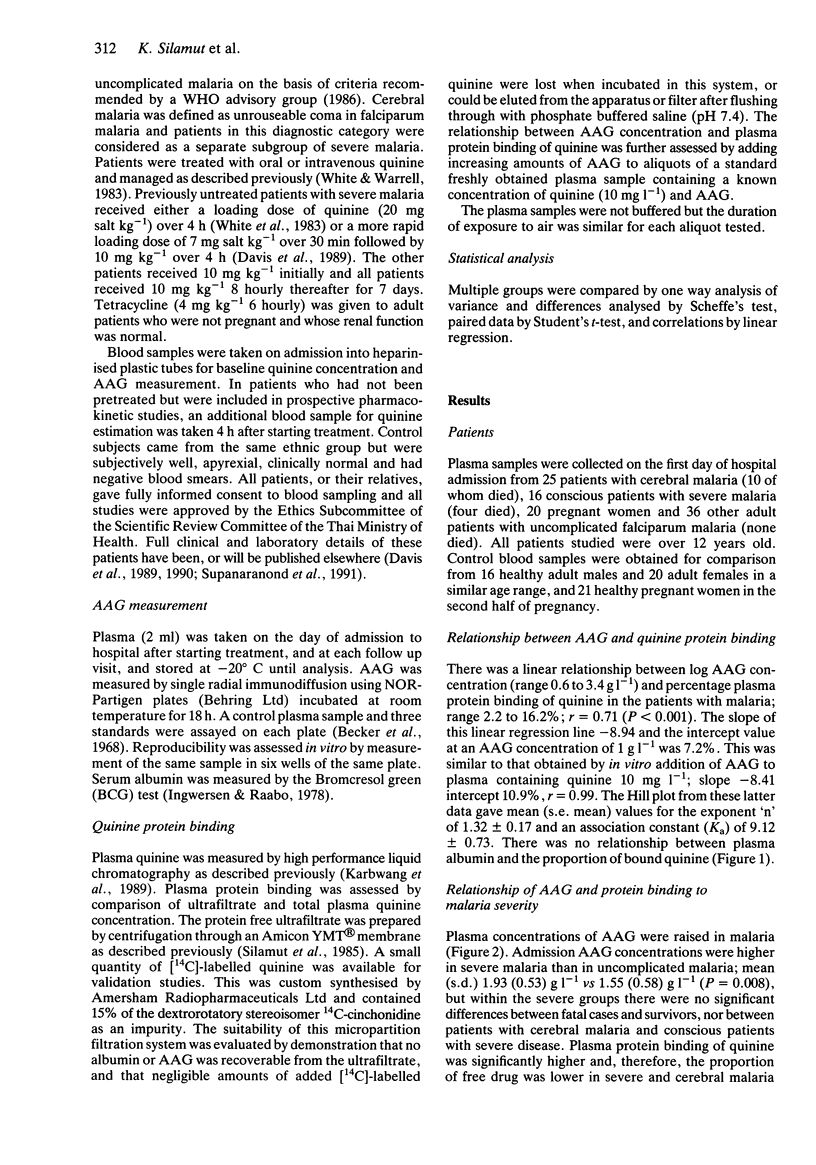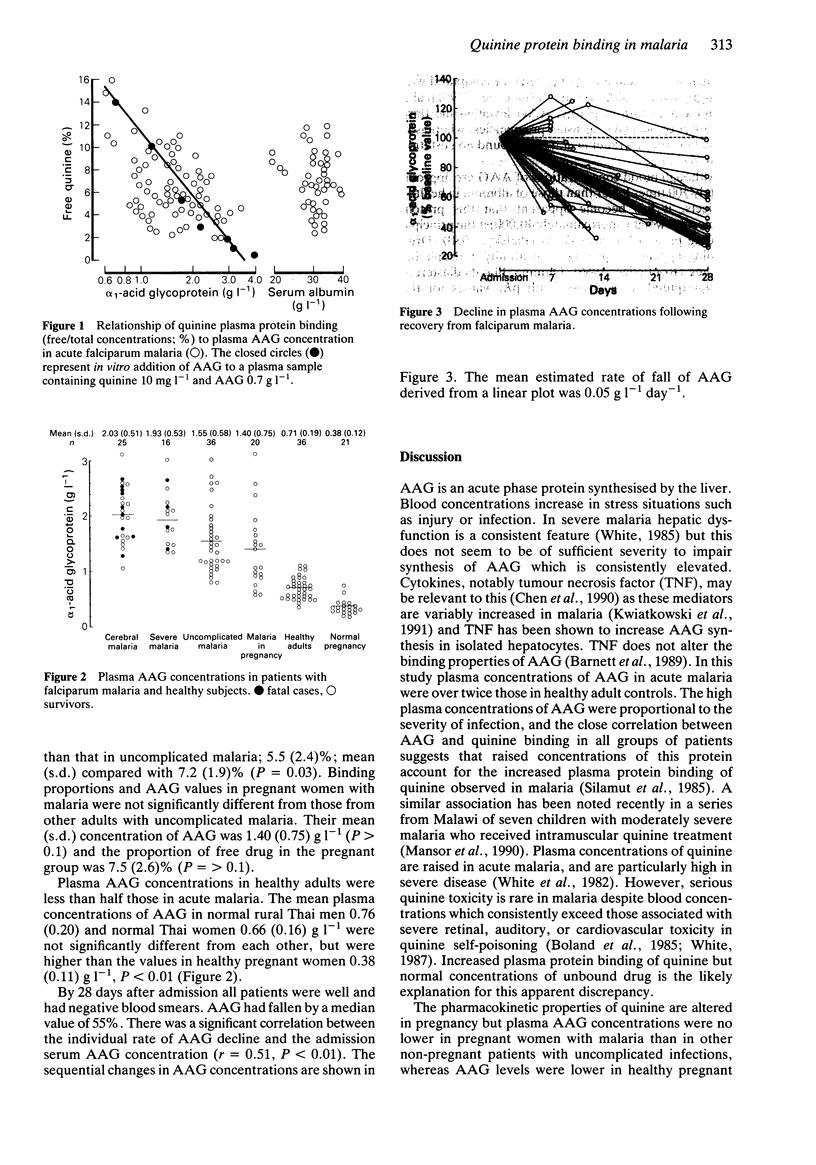Abstract
1. Plasma concentrations of alpha 1-acid glycoprotein (AAG) and plasma protein binding of quinine were measured in 97 Thai adults with acute falciparum malaria. There was a linear relationship between log AAG and percentage quinine binding (r = 0.71, P less than 0.001) in vivo, which was similar to that observed in vitro; the slopes and intercepts of the regression lines at AAG concentrations of 1 g l-1 were -8.94 and -8.41, and 7.2% and 10.9%, respectively. 2. Hill plots from these data suggest a single high affinity quinine binding site on each molecule of AAG. 3. Plasma AAG concentrations were consistently raised in acute malaria, and were higher in patients with cerebral malaria [2.03 (0.51) g l-1, mean (s.d.)], and conscious patients with severe malaria [1.93 (0.53) g l-1] than in patients with uncomplicated infections [1.55 (0.58) g l-1], P = 0.008. Plasma protein binding of quinine was correspondingly higher and thus the proportion of free drug was lower in the severe groups; 5.5 (2.4)% compared with 7.2 (1.9)%, P = 0.03. 4. Following recovery from malaria, plasma AAG concentrations fell by an estimated 0.05 g l-1 day-1 to levels that were approximately half (median 45%) the admission value at 28 days. 5. AAG is the principal binding protein for quinine in plasma. Changes in plasma concentrations of this acute phase reactant account for the increased plasma protein binding of quinine in acute malaria.
Full text
PDF




Selected References
These references are in PubMed. This may not be the complete list of references from this article.
- Barnett J. A., Brenner D. E., Creaven P. J., Lalka D. Lack of effect of treatment with human recombinant-tumour necrosis factor (HrTNF) on the binding of quinidine to alpha 1-acid glycoprotein (AGP). Br J Clin Pharmacol. 1989 Feb;27(2):257–261. doi: 10.1111/j.1365-2125.1989.tb05358.x. [DOI] [PMC free article] [PubMed] [Google Scholar]
- Becker W., Rapp W., Schwick H. G., Störiko K. Methoden zur quantitativen Bestimmung von Plasmaproteinen durch Immunpräzipitation. Z Klin Chem Klin Biochem. 1968 May;6(3):113–122. [PubMed] [Google Scholar]
- Boland M. E., Roper S. M., Henry J. A. Complications of quinine poisoning. Lancet. 1985 Feb 16;1(8425):384–385. doi: 10.1016/s0140-6736(85)91398-4. [DOI] [PubMed] [Google Scholar]
- CONN H. L., Jr, LUCHI R. J. Some quantitative aspects of the binding of quinidine and related quinoline compounds by human serum albumin. J Clin Invest. 1961 Mar;40:509–516. doi: 10.1172/JCI104278. [DOI] [PMC free article] [PubMed] [Google Scholar]
- Chu C. Y., Singla V. P., Wang H. P., Sweet B., Lai L. T. Plasma alpha 1-acid glycoprotein levels in pregnancy. Clin Chim Acta. 1981 May 5;112(2):235–240. doi: 10.1016/0009-8981(81)90382-x. [DOI] [PubMed] [Google Scholar]
- Davis T. M., Pukrittayakamee S., Supanaranond W., Looareesuwan S., Krishna S., Nagachinta B., Turner R. C., White N. J. Glucose metabolism in quinine-treated patients with uncomplicated falciparum malaria. Clin Endocrinol (Oxf) 1990 Dec;33(6):739–749. doi: 10.1111/j.1365-2265.1990.tb03911.x. [DOI] [PubMed] [Google Scholar]
- Davis T. M., Supanaranond W., Pukrittayakamee S., Karbwang J., Molunto P., Mekthon S., White N. J. A safe and effective consecutive-infusion regimen for rapid quinine loading in severe falciparum malaria. J Infect Dis. 1990 Jun;161(6):1305–1308. doi: 10.1093/infdis/161.6.1305. [DOI] [PubMed] [Google Scholar]
- Edwards D. J., Lalka D., Cerra F., Slaughter R. L. Alpha1-acid glycoprotein concentration and protein binding in trauma. Clin Pharmacol Ther. 1982 Jan;31(1):62–67. doi: 10.1038/clpt.1982.10. [DOI] [PubMed] [Google Scholar]
- Ingwersen S., Raabo E. Improved and more specific bromcresol green methods for the manual and automatic determination of serum albumin. Clin Chim Acta. 1978 Sep 15;88(3):545–550. doi: 10.1016/0009-8981(78)90290-5. [DOI] [PubMed] [Google Scholar]
- Karbwang J., Molunto P., Na Bangchang K., Bunnag D. Determination of mefloquine in biological fluids using high performance liquid chromatography. Southeast Asian J Trop Med Public Health. 1989 Mar;20(1):55–60. [PubMed] [Google Scholar]
- Kirkwood C. F., Edwards D. J., Lalka D., Lasezkay G., Hassett J. M., Slaughter R. L. The pharmacokinetics of meperidine in acute trauma patients. J Trauma. 1986 Dec;26(12):1090–1093. doi: 10.1097/00005373-198612000-00005. [DOI] [PubMed] [Google Scholar]
- Krauer B., Dayer P., Anner R. Changes in serum albumin and alpha 1-acid glycoprotein concentrations during pregnancy: an analysis of fetal-maternal pairs. Br J Obstet Gynaecol. 1984 Sep;91(9):875–881. doi: 10.1111/j.1471-0528.1984.tb03700.x. [DOI] [PubMed] [Google Scholar]
- Mansor S. M., Taylor T. E., McGrath C. S., Edwards G., Ward S. A., Wirima J. J., Molyneux M. E. The safety and kinetics of intramuscular quinine in Malawian children with moderately severe falciparum malaria. Trans R Soc Trop Med Hyg. 1990 Jul-Aug;84(4):482–487. doi: 10.1016/0035-9203(90)90007-2. [DOI] [PubMed] [Google Scholar]
- Mihaly G. W., Ching M. S., Klejn M. B., Paull J., Smallwood R. A. Differences in the binding of quinine and quinidine to plasma proteins. Br J Clin Pharmacol. 1987 Dec;24(6):769–774. doi: 10.1111/j.1365-2125.1987.tb03244.x. [DOI] [PMC free article] [PubMed] [Google Scholar]
- Pedersen L. E., Bonde J., Graudal N. A., Backer N. V., Hansen J. E., Kampmann J. P. Quantitative and qualitative binding characteristics of disopyramide in serum from patients with decreased renal and hepatic function. Br J Clin Pharmacol. 1987 Jan;23(1):41–46. doi: 10.1111/j.1365-2125.1987.tb03007.x. [DOI] [PMC free article] [PubMed] [Google Scholar]
- Piafsky K. M. Disease-induced changes in the plasma binding of basic drugs. Clin Pharmacokinet. 1980 May-Jun;5(3):246–262. doi: 10.2165/00003088-198005030-00004. [DOI] [PubMed] [Google Scholar]
- Routledge P. A. The plasma protein binding of basic drugs. Br J Clin Pharmacol. 1986 Nov;22(5):499–506. doi: 10.1111/j.1365-2125.1986.tb02927.x. [DOI] [PMC free article] [PubMed] [Google Scholar]
- Silamut K., White N. J., Looareesuwan S., Warrell D. A. Binding of quinine to plasma proteins in falciparum malaria. Am J Trop Med Hyg. 1985 Jul;34(4):681–686. doi: 10.4269/ajtmh.1985.34.681. [DOI] [PubMed] [Google Scholar]
- Supanaranond W., Davis T. M., Pukrittayakamee S., Silamut K., Karbwang J., Molunto P., Chanond L., White N. J. Disposition of oral quinine in acute falciparum malaria. Eur J Clin Pharmacol. 1991;40(1):49–52. doi: 10.1007/BF00315138. [DOI] [PubMed] [Google Scholar]
- Veering B. T., Burm A. G., Souverijn J. H., Serree J. M., Spierdijk J. The effect of age on serum concentrations of albumin and alpha 1-acid glycoprotein. Br J Clin Pharmacol. 1990 Feb;29(2):201–206. doi: 10.1111/j.1365-2125.1990.tb03620.x. [DOI] [PMC free article] [PubMed] [Google Scholar]
- White N. J. Clinical pharmacokinetics of antimalarial drugs. Clin Pharmacokinet. 1985 May-Jun;10(3):187–215. doi: 10.2165/00003088-198510030-00001. [DOI] [PubMed] [Google Scholar]
- White N. J., Looareesuwan S., Warrell D. A., Warrell M. J., Bunnag D., Harinasuta T. Quinine pharmacokinetics and toxicity in cerebral and uncomplicated Falciparum malaria. Am J Med. 1982 Oct;73(4):564–572. doi: 10.1016/0002-9343(82)90337-0. [DOI] [PubMed] [Google Scholar]
- White N. J., Looareesuwan S., Warrell D. A., Warrell M. J., Chanthavanich P., Bunnag D., Harinasuta T. Quinine loading dose in cerebral malaria. Am J Trop Med Hyg. 1983 Jan;32(1):1–5. doi: 10.4269/ajtmh.1983.32.1. [DOI] [PubMed] [Google Scholar]
- White N. J. The pharmacokinetics of quinine and quinidine in malaria. Acta Leiden. 1987;55:65–76. [PubMed] [Google Scholar]
- White N. J. The treatment of falciparum malaria. Parasitol Today. 1988 Jan;4(1):10–14. doi: 10.1016/0169-4758(88)90048-8. [DOI] [PubMed] [Google Scholar]
- White N. J., Warrell D. A. Clinical management of chloroquine-resistant Plasmodium falciparum malaria in Southeast Asia. Trop Doct. 1983 Oct;13(4):153–158. doi: 10.1177/004947558301300405. [DOI] [PubMed] [Google Scholar]


